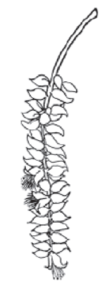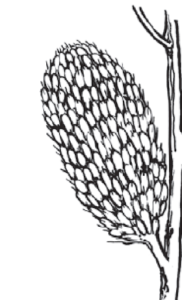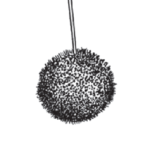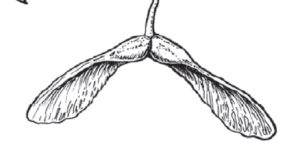by Deya Ramsden, Virginia Department of Forestry’s Middle James River Forest Watershed Project Coordinator

Riparian areas are dynamic ecosystems that are affected by flooding and the movement of water. Trees common to stream and riverbanks have adapted to this dynamic environment in a number of ways. One of those adaptations starts with the dispersal and movement of seeds. The tree species I will describe below have seeds and fruits that travel by wind and water to find their perfect place to take root. These same species are common in planted buffers due to their preference for the streamside environment.
Black willow (Salix nigra) produces abundant seeds April through July. The seeds are encapsulate in long silky hairs that are carried by wind and float on water. The seeds must germinate quickly on very moist to wet soils, sometimes on sandbars, to avoid drying out. The stems of willow also have the unique ability to root easily. When planning a riparian buffer “live stakes” of willow can be used to form thickets along banks.
 River birch (Betula nigra) has winged seeds that move by both wind and water. Like the willow seed those of birch germinate on moist, and often newly formed soils. Although the stems of birch do not root like willow, the stump of river birch will easily re-sprout, making it resilient in the dynamic environment.
River birch (Betula nigra) has winged seeds that move by both wind and water. Like the willow seed those of birch germinate on moist, and often newly formed soils. Although the stems of birch do not root like willow, the stump of river birch will easily re-sprout, making it resilient in the dynamic environment.
 American sycamore (Platanus occidentalis) is well adapted to the riparian environment, tolerant of the kind of submersion that occurs with seasonal flooding. The seed ball often breaks apart in very early spring. The small tufts on each seed can travel up to 300 feet from the parent tree. Although mostly wind dispersed, when it can also move in water. Seed release often corresponds with the receding of spring flood waters, when new soil, such as mudflats form along river banks, which is an excellent place for sycamore to germinate. In a naturally regenerated buffer you may find an almost uniform stand of young sycamore due to its abundance of seed.
American sycamore (Platanus occidentalis) is well adapted to the riparian environment, tolerant of the kind of submersion that occurs with seasonal flooding. The seed ball often breaks apart in very early spring. The small tufts on each seed can travel up to 300 feet from the parent tree. Although mostly wind dispersed, when it can also move in water. Seed release often corresponds with the receding of spring flood waters, when new soil, such as mudflats form along river banks, which is an excellent place for sycamore to germinate. In a naturally regenerated buffer you may find an almost uniform stand of young sycamore due to its abundance of seed.
 Silver maple (Acer saccharinum) with their twirly samaras may be the first wind dispersed seed we learn of as children. Samaras start to fall in late spring and may travel over 300 feet from the mother tree. Seeds may germinate immediately in the right place but, may also may last for over a year in the soil. Like the willow and sycamore silver maple seedlings can survive when submerged in water and grow soils in that are saturated much of the year. Unlike willow and sycamore maples prefer to grow in soils with some organic matter (i.e. leaf litter) and can tolerate some shading from other trees.
Silver maple (Acer saccharinum) with their twirly samaras may be the first wind dispersed seed we learn of as children. Samaras start to fall in late spring and may travel over 300 feet from the mother tree. Seeds may germinate immediately in the right place but, may also may last for over a year in the soil. Like the willow and sycamore silver maple seedlings can survive when submerged in water and grow soils in that are saturated much of the year. Unlike willow and sycamore maples prefer to grow in soils with some organic matter (i.e. leaf litter) and can tolerate some shading from other trees.
I find it lovely to picture the movement of the seeds and fruits of these riverside trees from the branches through the wind and down into the water until they find their perfect forever home.
Happy winter solstice everyone!
References
Fire Effects Information System (FEIS). USDA – U.S. Forest Service.
https://www.feis-crs.org/feis/
Plants Database. USDA – Natural Resource Conservation Service. https://plants.usda.gov/java/
Illustrations taken from:
Common Native Trees of Virginia: Identification Guide. Virginia Department of Forestry. https://www.dof.virginia.gov/infopubs/Native-Tree-ID_2020.pdf
